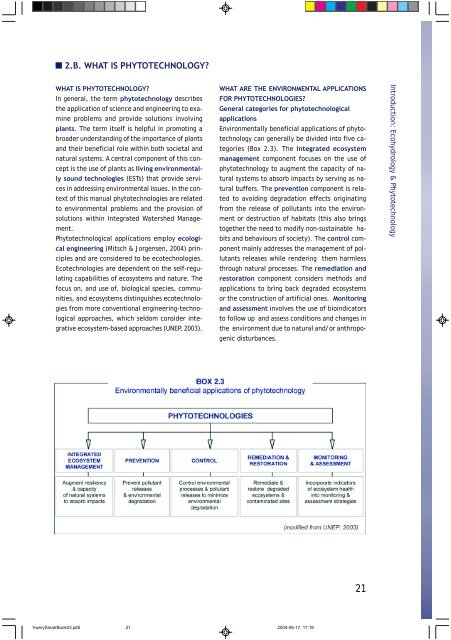Manual - International Environmental Technology Centre
Manual - International Environmental Technology Centre
Manual - International Environmental Technology Centre
You also want an ePaper? Increase the reach of your titles
YUMPU automatically turns print PDFs into web optimized ePapers that Google loves.
2.B. WHAT IS PHYTOTECHNOLOGY?<br />
WHAT IS PHYTOTECHNOLOGY?<br />
In general, the term phytotechnology describes<br />
the application of science and engineering to examine<br />
problems and provide solutions involving<br />
plants. The term itself is helpful in promoting a<br />
broader understanding of the importance of plants<br />
and their beneficial role within both societal and<br />
natural systems. A central component of this concept<br />
is the use of plants as living environmentally<br />
sound technologies (ESTs) that provide services<br />
in addressing environmental issues. In the context<br />
of this manual phytotechnologies are related<br />
to environmental problems and the provision of<br />
solutions within Integrated Watershed Management.<br />
Phytotechnological applications employ ecological<br />
engineering (Mitsch & Jorgensen, 2004) principles<br />
and are considered to be ecotechnologies.<br />
Ecotechnologies are dependent on the self-regulating<br />
capabilities of ecosystems and nature. The<br />
focus on, and use of, biological species, communities,<br />
and ecosystems distinguishes ecotechnologies<br />
from more conventional engineering-technological<br />
approaches, which seldom consider integrative<br />
ecosystem-based approaches (UNEP, 2003).<br />
WHAT ARE THE ENVIRONMENTAL APPLICATIONS<br />
FOR PHYTOTECHNOLOGIES?<br />
General categories for phytotechnological<br />
applications<br />
<strong>Environmental</strong>ly beneficial applications of phytotechnology<br />
can generally be divided into five categories<br />
(Box 2.3). The integrated ecosystem<br />
management component focuses on the use of<br />
phytotechnology to augment the capacity of natural<br />
systems to absorb impacts by serving as natural<br />
buffers. The prevention component is related<br />
to avoiding degradation effects originating<br />
from the release of pollutants into the environment<br />
or destruction of habitats (this also brings<br />
together the need to modify non-sustainable habits<br />
and behaviours of society). The control component<br />
mainly addresses the management of pollutants<br />
releases while rendering them harmless<br />
through natural processes. The remediation and<br />
restoration component considers methods and<br />
applications to bring back degraded ecosystems<br />
or the construction of artificial ones. Monitoring<br />
and assessment involves the use of bioindicators<br />
to follow up and assess conditions and changes in<br />
the environment due to natural and/or anthropogenic<br />
disturbances.<br />
VwerySmatrBook03.p65 21<br />
2004-06-17, 17:18<br />
21<br />
Introduction: Ecohydrology & Phytotechnology

















